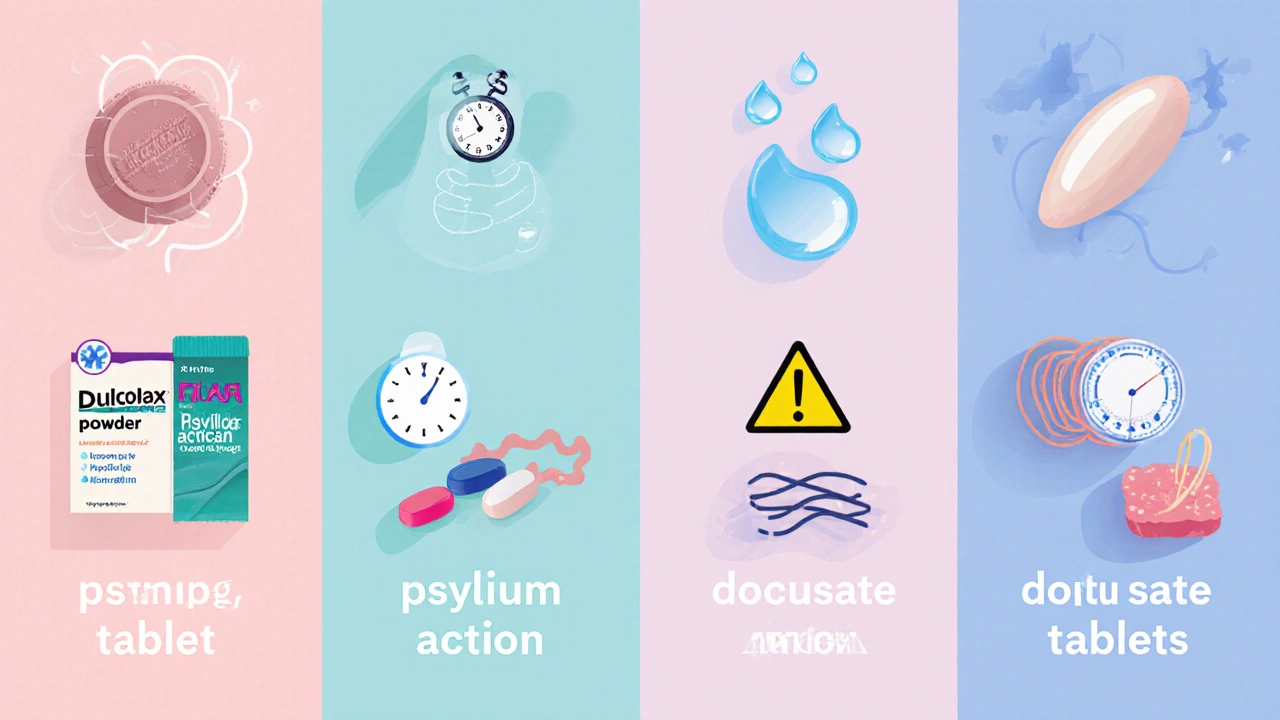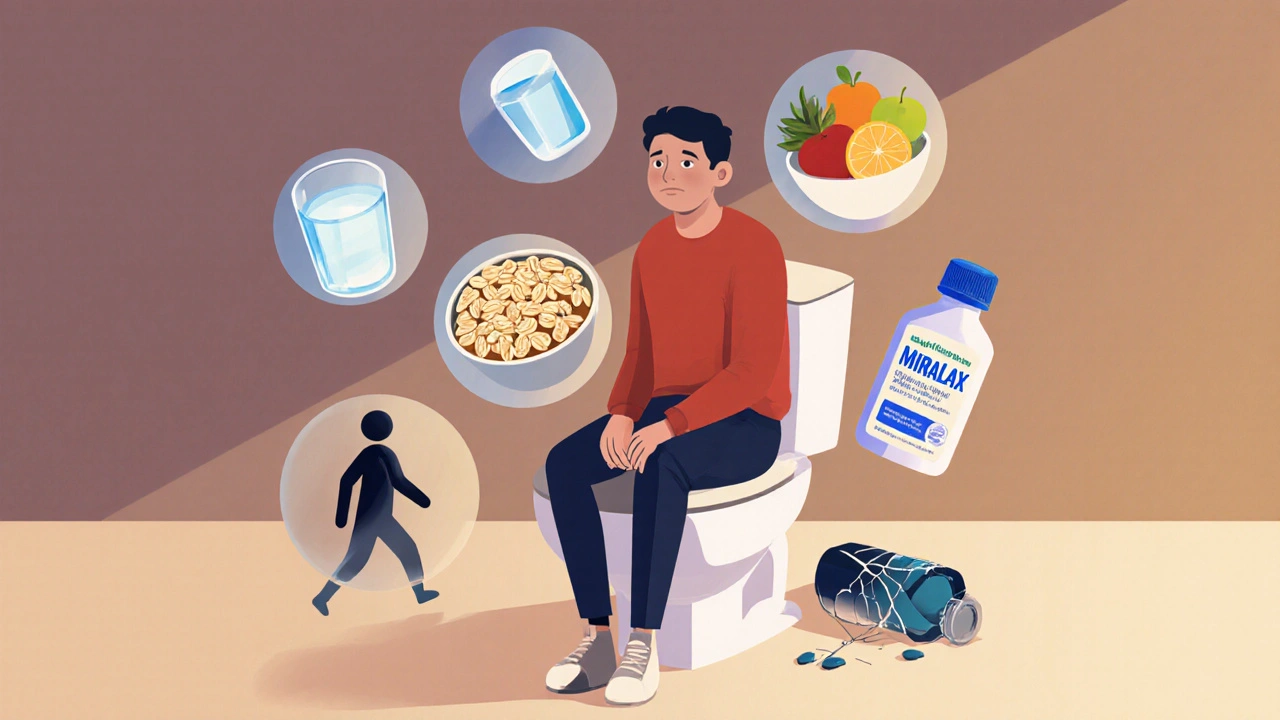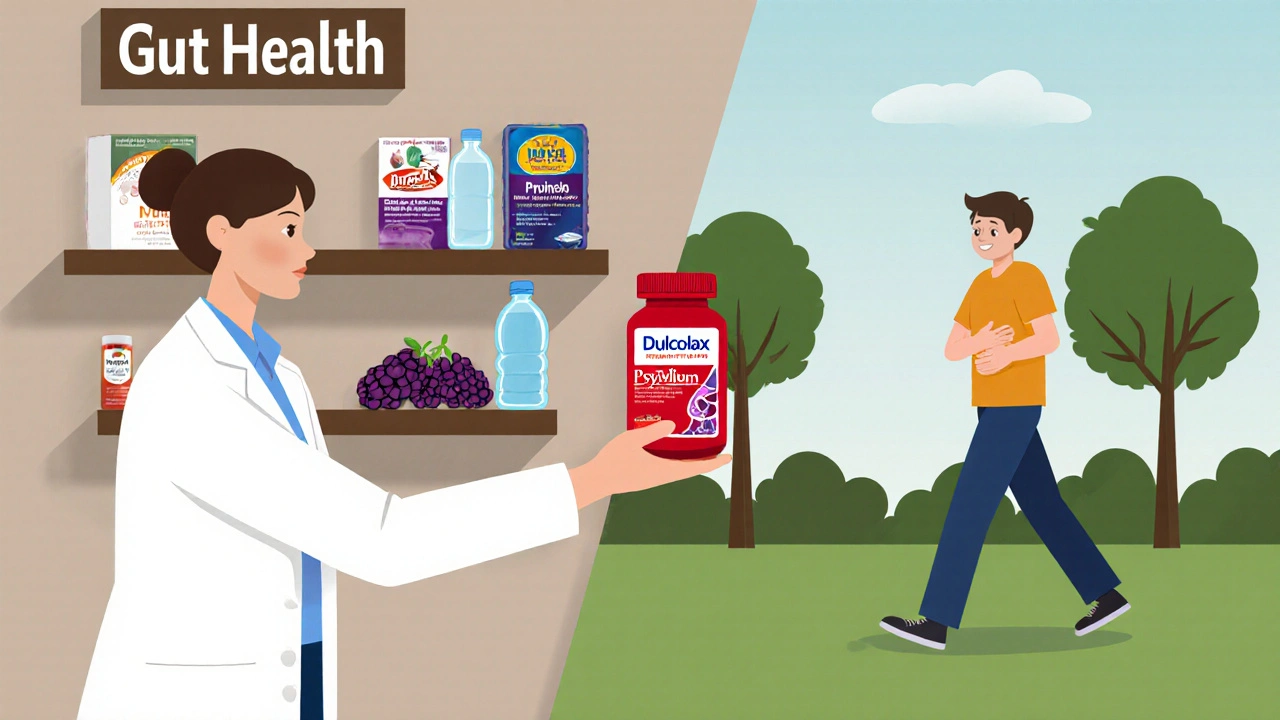Dulcolax vs Alternatives: What Works Best for Constipation Relief?
 Nov, 18 2025
Nov, 18 2025
Constipation isn’t just uncomfortable-it can feel like your body’s stuck in slow motion. If you’ve reached for Dulcolax (bisacodyl) and wondered if there’s something better, faster, or gentler, you’re not alone. Millions turn to stimulant laxatives like Dulcolax when nothing else works. But it’s not the only option. And not always the best one. Let’s break down how Dulcolax stacks up against other common treatments, what actually works, and when to pick one over the other.
What is Dulcolax (bisacodyl)?
Dulcolax is a stimulant laxative containing bisacodyl, a compound that triggers muscle contractions in the colon to push stool out. It’s available as tablets, suppositories, and liquids, with tablets taking 6-12 hours to work and suppositories working in 15-60 minutes. It’s fast, effective, and often used for occasional constipation or before medical procedures. But it doesn’t soften stool-it forces it out. That’s why some people feel cramps or urgency after taking it.
Used correctly, Dulcolax is safe for short-term relief. But if you’re relying on it weekly, you’re masking a deeper issue. Long-term use can lead to dependency, electrolyte imbalances, or even damage to colon nerves. The FDA warns against using stimulant laxatives for more than a week without medical advice.
Stool softeners: Docusate sodium (Colace)
Stool softeners like docusate sodium (Colace) work differently. Instead of stirring up contractions, they let water and fat seep into the stool so it becomes softer and easier to pass. They’re ideal for people who need to avoid straining-like after surgery, childbirth, or with hemorrhoids.
Here’s the catch: docusate doesn’t work fast. It can take 1-3 days to show results. If you’re desperate for relief today, it won’t help. But if you’re managing chronic constipation, especially if you’re on painkillers or iron supplements, docusate is gentler and safer for daily use than Dulcolax.
Studies show docusate is no more effective than placebo for acute constipation-but it’s far better for long-term use. Think of it like moisturizing dry skin instead of scrubbing it raw.
Osmostic laxatives: Polyethylene glycol (MiraLAX)
Polyethylene glycol (MiraLAX) is the go-to for doctors treating chronic constipation. It draws water into the colon naturally, without irritating the bowel lining. It’s not a stimulant. No cramps. No urgency. Just gradual, gentle relief-usually in 1-3 days.
Unlike Dulcolax, MiraLAX is safe for daily use in adults and kids. The American College of Gastroenterology recommends it as first-line therapy for chronic constipation. It’s also the laxative most often used in bowel prep for colonoscopies because it doesn’t cause dehydration or electrolyte loss like older options.
One downside? It’s not fast. If you need relief within hours, MiraLAX won’t cut it. But if you’re looking for something you can take regularly without fear of dependency, it’s the clear winner over bisacodyl.
Bulk-forming laxatives: Psyllium (Metamucil)
Psyllium (Metamucil) is fiber. Real, plant-based fiber. It absorbs water and swells up, creating bulk that triggers natural bowel movements. It’s the most natural option on this list.
It’s also the slowest-takes 12-72 hours. But it’s the only one that actually improves your gut health long-term. Regular use lowers cholesterol, stabilizes blood sugar, and feeds good gut bacteria. People with IBS-C (constipation-predominant irritable bowel syndrome) often find psyllium helps more than any pill.
But here’s the catch: you have to drink enough water. If you take psyllium without enough fluid, you can get blocked. It’s also not ideal if you’re bloated or have severe constipation. But for prevention, maintenance, and overall digestive wellness, it’s unmatched.

Comparison: Dulcolax vs Alternatives
| Option | Type | Time to Work | Best For | Long-Term Safe? | Side Effects |
|---|---|---|---|---|---|
| Dulcolax (bisacodyl) | Stimulant | 6-12 hours (tablet), 15-60 min (suppository) | Quick relief, pre-procedure use | No | Cramps, urgency, dependency risk |
| Docusate sodium (Colace) | Stool softener | 1-3 days | Post-surgery, hemorrhoids, painkiller users | Yes | Mild bloating, rare nausea |
| Polyethylene glycol (MiraLAX) | Osmotic | 1-3 days | Chronic constipation, kids, elderly | Yes | Bloating, gas |
| Psyllium (Metamucil) | Bulk-forming | 12-72 hours | Prevention, gut health, IBS-C | Yes | Bloating if not enough water |
When to choose Dulcolax
Dulcolax makes sense in three situations:
- You need fast relief before a medical test or procedure.
- You’ve tried gentler options and nothing worked.
- You’re using it once, rarely, and not relying on it.
If you’re taking it more than once a week, you’re likely treating a symptom, not the cause. Common underlying issues include low fiber intake, dehydration, lack of movement, or side effects from medications like opioids or antidepressants.
When to avoid Dulcolax
Don’t use Dulcolax if you have:
- Abdominal pain or nausea (could be appendicitis or obstruction)
- Chronic constipation without trying diet or osmotic laxatives first
- Electrolyte imbalances (low potassium, for example)
- Intestinal blockage or inflammatory bowel disease
Also, avoid it if you’re pregnant or breastfeeding unless your doctor says it’s okay. The suppository form is often preferred during pregnancy because it acts locally and has less systemic absorption.

What doctors recommend instead
Most gastroenterologists in Australia and the U.S. follow the same advice: start with lifestyle, then bulk-forming or osmotic laxatives before stimulants.
Here’s the typical path:
- Drink more water-aim for 2-2.5 liters a day.
- Add 25-30g of fiber daily from oats, beans, vegetables, and fruit.
- Move more-even a 20-minute walk after meals helps.
- If that doesn’t help, try psyllium or MiraLAX daily for 1-2 weeks.
- If still stuck, consider docusate for softening.
- Only then, if absolutely necessary, use Dulcolax for a single dose.
This approach works because it treats the root problem: slow transit and hard stool-not just the symptom.
Real-world experience: What people actually use
In Melbourne, pharmacists report that MiraLAX and psyllium are now the top choices for regular constipation. Dulcolax still sells well-but mostly for emergency use or after people have tried everything else.
One 62-year-old woman I spoke with had been taking Dulcolax every other day for 8 years. She felt fine. But when she switched to MiraLAX and added flaxseed to her breakfast, her cramps vanished, her energy improved, and she hasn’t needed a stimulant in 14 months.
That’s the pattern. People don’t realize they’ve built a dependency. They think the pill is working. But their body’s just been trained to need a kickstart.
Final advice: What to do next
If you’re reading this because Dulcolax didn’t work or you’re tired of side effects, here’s your action plan:
- Stop using Dulcolax daily. Use it only for emergencies.
- Start taking MiraLAX (17g daily) or psyllium (5-10g with water) for 1-2 weeks.
- Track your bowel movements. Note how you feel, not just frequency.
- If no improvement in 10 days, see your GP. There could be an underlying condition like hypothyroidism or pelvic floor dysfunction.
Constipation isn’t a pill problem. It’s usually a lifestyle problem. And fixing it doesn’t require a stronger laxative. It requires patience, water, fiber, and movement.
Is Dulcolax stronger than MiraLAX?
Dulcolax works faster but is harsher. MiraLAX is gentler and safer for daily use. Dulcolax forces contractions; MiraLAX draws water naturally. For quick relief, Dulcolax wins. For long-term use, MiraLAX is better.
Can I take Dulcolax and MiraLAX together?
Yes, but only under medical guidance. Combining them can increase the risk of cramps and dehydration. Most people don’t need both. If MiraLAX isn’t working after 3 days, switch to Dulcolax for one dose-not both.
What’s the safest laxative for seniors?
MiraLAX and psyllium are safest. Seniors often have slower digestion and are on medications that cause constipation. Stimulants like Dulcolax can cause electrolyte imbalances or falls due to urgency. Osmotic and bulk-forming laxatives are preferred by geriatric guidelines.
Does Dulcolax cause weight loss?
No. Any weight loss from Dulcolax is just water and stool, not fat. Using it for weight loss is dangerous and can lead to dehydration, nutrient loss, and bowel damage. It’s not a weight-loss tool.
How long can I take bisacodyl safely?
The FDA and Australian Therapeutic Goods Administration recommend no more than 7 days of continuous use without medical advice. Longer use risks dependency, reduced bowel tone, and nerve damage. If you need laxatives longer than a week, see a doctor.
Are there natural alternatives to Dulcolax?
Yes. Prunes, figs, chia seeds, flaxseed, and kiwi fruit contain natural fiber and sorbitol that help move stool. Drinking warm water with lemon in the morning and walking after meals also helps. These aren’t fast, but they’re safe and support long-term gut health.
What to do if nothing works
If you’ve tried fiber, water, MiraLAX, psyllium, and even Dulcolax-and you’re still stuck-don’t keep trying stronger laxatives. See your doctor. You might need tests for thyroid function, diabetes, pelvic floor disorders, or colon motility issues. Constipation that lasts more than 3 weeks isn’t normal. It’s a signal.
There’s no magic pill. But there is a better way: treat the cause, not just the symptom. Your body doesn’t need to be forced. It just needs the right conditions to work.
Ashley Miller
November 20, 2025 AT 03:58Of course Dulcolax is the FDA’s little pet project. Did you know they banned real fiber in 1998 to boost pharma sales? They replaced it with MiraLAX because it’s easier to patent. Your colon doesn’t need water-it needs rebellion. 💀
Sherri Naslund
November 21, 2025 AT 06:47lol so ur sayin i gotta drink water and eat veggies? wow. mind blown. next u’ll tell me i should stop sitting on the couch eating cheetos while watching youtube videos about how laxatives are a gateway to freedom. also, psyllium? that’s just plant dust with delusions of grandeur. i need a kick, not a hug.
Martin Rodrigue
November 21, 2025 AT 18:31While the article presents a clinically sound comparative analysis of laxative modalities, it is regrettable that the tone veers into populist simplification. The assertion that constipation is 'a lifestyle problem' ignores the neurogastroenterological complexity of motility disorders. The American College of Gastroenterology guidelines explicitly endorse osmotic agents as first-line, not because they are 'gentler,' but because they demonstrate superior efficacy in randomized controlled trials with low heterogeneity. To reduce this to a matter of 'drinking water' is to misunderstand pathophysiology.
Greg Knight
November 22, 2025 AT 09:45Hey, I’ve been there. For years I was on Dulcolax like it was my morning coffee-until I hit 40 and my gut started screaming. I switched to MiraLAX, started walking after dinner, and added flaxseed to my oatmeal. Not overnight magic, but after 3 weeks? My body felt like it remembered how to work. You’re not broken. You’re just out of rhythm. Give your gut a chance to heal, not just blast it. You got this.
Hannah Machiorlete
November 23, 2025 AT 23:25So let me get this straight-you’re telling me the real enemy isn’t Dulcolax, it’s my laziness? My poor diet? My 12-hour workdays? Like, I don’t have time to soak chia seeds and meditate with my colon. I have a Zoom meeting in 5 minutes. This article is just guilt wrapped in a fiber supplement. I’ll keep my bisacodyl and my resentment, thanks.
Kenneth Meyer
November 25, 2025 AT 20:56There’s a deeper truth here: our society treats the body like a machine that needs a wrench, not a garden that needs care. We don’t ask why the soil is barren-we just throw in fertilizer and call it a day. Dulcolax is the chemical equivalent of a sledgehammer to a seedling. MiraLAX and psyllium? They’re the rain and the compost. We’ve forgotten that health isn’t a quick fix-it’s a daily conversation with your biology.
Donald Sanchez
November 27, 2025 AT 20:27ok so mirlax is the new chill vibe but like… why does it take 3 days?? i need to go NOW. also i tried psyllium once and i felt like my stomach was a balloon filled with gravel. also i put a emoji on it 🤮. also my cousin’s dog takes MiraLAX and he’s fine so it’s prob safe? right? also i’m 23 why do i have to eat oats??
Abdula'aziz Muhammad Nasir
November 29, 2025 AT 03:57As a pharmacist in Lagos, I see this daily. Many patients come in asking for Dulcolax because they’ve heard it’s 'strong.' But when we explain the risks-dependency, nerve damage, electrolyte chaos-they often say, 'But doctor, I’ve been taking it for years.' The solution isn’t another pill. It’s education. Water. Fiber. Movement. Simple. But in our fast world, we want miracles, not habits. I always tell them: Your body isn’t broken. It’s just ignored.
Tara Stelluti
November 30, 2025 AT 04:54I used to take Dulcolax every Tuesday like a ritual. Then I started journaling. Turns out, every time I took it, I’d just had a fight with my mom. Coincidence? I think not. My colon was screaming for emotional release. Now I cry into my psyllium. It’s less embarrassing than cramping in the bathroom while my cat judges me.
Danielle Mazur
December 1, 2025 AT 07:00Did you know the FDA approved Dulcolax in 1952 after a secret deal with Big Pharma? The real reason they warn against long-term use? Because if you use it too much, your body stops buying their other drugs. They want you addicted to the symptoms so you keep buying the fixes. They don’t want you healthy. They want you profitable.
Margaret Wilson
December 1, 2025 AT 18:17OMG I switched to MiraLAX and now I’m basically a new person. No more panic attacks before I leave the house. I feel like my insides finally trust me. I even started hugging trees. Not joking. My gut is healed. I’m glowing. 🌿✨
Lauren Hale
December 2, 2025 AT 12:30For anyone reading this and feeling overwhelmed-start small. One extra glass of water. One apple a day. A 10-minute walk. You don’t need to overhaul your life. Just begin. Progress isn’t about perfection. It’s about showing up, even when it feels pointless. Your body remembers every kind choice you make.
rachna jafri
December 3, 2025 AT 20:26Western medicine is a scam. Why do you think they push pills? Because Indians have been using triphala, amla, and warm water with ghee since Vedic times-and we never had colon cancer epidemics. Dulcolax? That’s colonial poison disguised as science. Your body knows. Listen to your ancestors, not your pharma ads.
darnell hunter
December 4, 2025 AT 14:58The article’s methodology is methodologically unsound. The anecdotal evidence presented, particularly regarding the 62-year-old woman, constitutes a case study with no control variables. The recommendation to replace stimulant laxatives with osmotic agents is clinically valid, yet the rhetorical framing undermines its credibility by appealing to emotional narratives rather than evidence-based protocols. One cannot substitute anecdote for algorithm.
Bette Rivas
December 6, 2025 AT 04:18As a GI nurse for 18 years, I’ve seen patients on Dulcolax for decades. Some develop colonic inertia-where the colon literally forgets how to contract. The worst cases? Elderly patients who fall trying to get to the bathroom after a suppository. MiraLAX and psyllium are safer, yes-but the real win is prevention. Fiber isn’t optional. It’s oxygen for your gut. And water? It’s not a suggestion. It’s a requirement. Start today. Not tomorrow. Today.